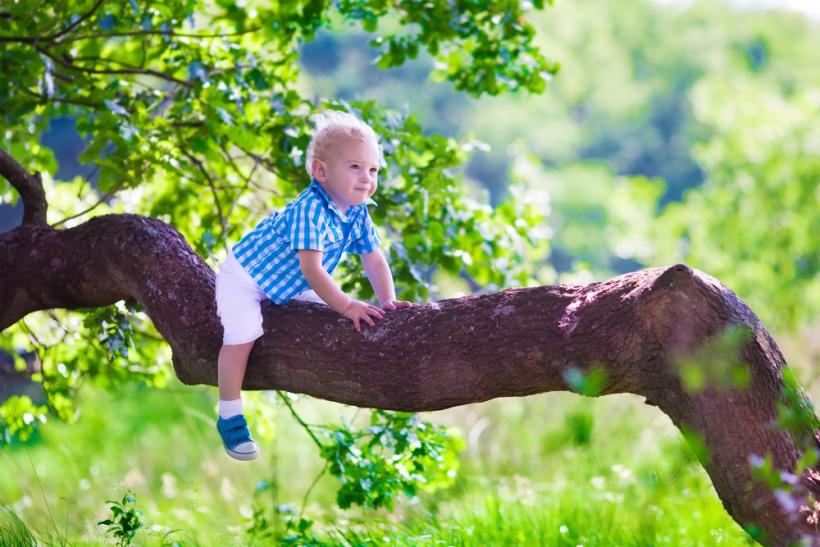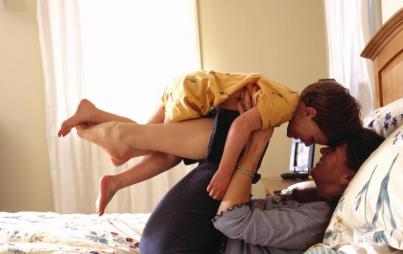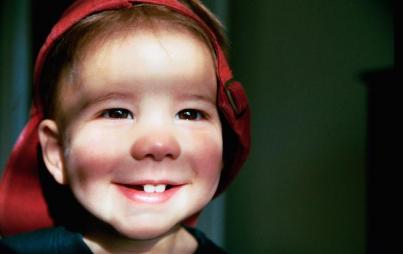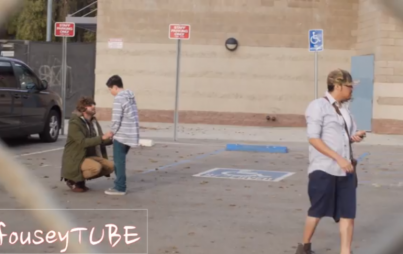
None of us follows any one parenting philosophy to a T; we’re all making split-second decisions about what is and isn’t dangerous.
When my child was just a year old, a friend stopped by while I was out playing in our neighborhood with them. We had wandered into a neighbor’s yard, which serves as a kind of de-facto playground, and the baby was happily climbing on a pile of siding our neighbors had laid out, ready to go on their house. My kid was still somewhat unsteady but wanted to try their best, especially since they had seen bigger kids playing on the same pile. I stood a self-conscious five to ten feet away talking with my friend, who has a child a few years older.
“You’re doing really good!” she said, “I’m impressed, it’s so hard not to be a helicopter mom.”
Without thinking, I responded, “Oh, well there’s been pressure to loosen up, there are a lot of free range parents around here. I think they see us as the uptight ones!”
Free-range parenting tends to value the skills kids learn by trying new things and playing independently over the potential risks, and in many ways, I agree with them. But, the truth is that while being around free-range parents may have helped shape my parenting style in some ways, I am not a free-range parent myself.
I religiously follow my own parenting philosophy, which I like to call “Just Keep Them Out Of The Emergency Room” parenting, or JKTOOTER for short.
In an age when parenting styles have been carefully named and categorized, a time of crunchy mamas and hippie mamas and yes, free-range mamas, I think it’s high time to name JKTOOTER parenting for what it is. JKTOOTER is a rich and complex parenting philosophy, which, just like many of the parenting movements that came before, is difficult to sum up in one short article.
The cornerstone of the philosophy is this: JKTOOTER parents have a deep and abiding desire not to be so-called “helicopter parents,” and may even desire to implement some aspects of free-range parenting ideals (though this can vary). What sets the JKTOOTER parent apart is that we tend to view all of our children’s activities, and whether or not we intervene, through the lens of one all-consuming questions:
“Will this land my kid in the ER?”
So, for example, if a small child is climbing on a low pile of building materials, the JKTOOTER parents carefully assesses the situation. How likely is the child to fall? In this case, the answer is extremely likely. If the child does fall, what kind of injury is most likely to be the result?
While recognizing that we can never predict with 100% accuracy what may or may not lead to a family trip to the emergency room, we can make some educated guesses, and perhaps come to the conclusion that while the kid is almost definitely going to take a spill at some point, they’re low enough to the ground that unless something very odd happens, minor bumps and bruises will be the worst of it. In an exercise of quick mental math, it’s possible to determine that a trip to the hospital is improbable. In this case, the average JKTOOTER parent will conclude that it’s a good time to let the child try their strength and figure things out for themselves. However, the same child scrambling up a tall play structure after a larger child may garner a different result. It isn’t that the JKTOOTER parent doesn’t want to allow their child to take risks.
You Might Also Like: The One Question That Halted My Helicopter Parenting
On the contrary, we understand that risks are an essential part of childhood development and represent a chance to learn and grow! But as the risks increase, the Just Keep Them Out Of The Emergency Room philosophy dictates that we, well, try to keep our kiddos out of the hospital. From the outside, this may look moderately confusing to those unfamiliar with JKTOOTER. We may be found hovering around our kids during particularly risky moments, or even discouraging certain risk-taking behaviors, as the odds of an emergency room visit increase. While at other times, we give our kids a lot of freedom, and perhaps even seem overly lax.
At this point, you are probably wondering, why JKTOOTER? And how can I tell if JKTOOTER is right for me?
Well, to put it simply, going to the emergency room sucks. It sucks for parents; it sucks for kids; it sucks for everyone. Hospitals are deeply unpleasant places for most people, and no one wants to see their child so badly hurt that they need emergency medical care. I cannot tell another parent, any other parent, with certainty, that the JKTOOTER lifestyle is right for them. I can only tell you what I know; Using a JKTOOTER framework in my own parenting has helped me to feel confident about more of my parenting decisions, and has helped me avoid the awful specter of parenting guilt both when I’m a little lenient as a parent, and when I’m more on the controlling side. JKTOOTER works for my family and me, and at the end of the day, that’s the most important thing.
Like every other parenting ideology under the sun, JKTOOTER is bound to have a few naysayers and detractors! Parents who are full-tilt free rangers will likely point out that while free-range parents might be seen as overly permissive, the ideology already includes the simple fact that none of us want our kids to go to the hospital and common sense limits make sense. On the other side of the coin, the more uptight parents may mention that you know, childhood is an endless series of injury risks, and since you can never know which one will lead to that ER trip, minimizing as many of them as possible is the only thing that makes sense. They are valid arguments, but they fail to account for what JKTOOTER really adds to the parenting conversation.
There’s just one compelling case against JKTOOTER that I can’t ignore.
The fact is, sometimes kids have to go to the ER. Sometimes it isn’t a risk we can manage or mitigate. Sometimes, in the most mundane situations, through entirely standard parts of childhood that no one would have guessed would be dangerous, children need emergency medical attention.
When I was growing up, my older sister broke her arm twice. The first time she was skipping down the driveway, the second time walking in sand. Not even the most paranoid of helicopter parents would stop an eight-year-old from walking in sand!
When some hardcore free-range parents I know ended up in the hospital with their toddler, it wasn’t because of any of the more “free range-y” things that child did. Another family’s kid lost a couple of teeth falling on the steps, and it wasn’t because no one was there to tell him to be careful, he just happened to slip in precisely the wrong way.
Life happens. Kids get hurt. None of us follows any one parenting philosophy to a T; we’re all making split-second decisions about what is and isn’t dangerous, and we can’t always be right. No matter how we identify as parents, we struggle, we do our best, and we do screw up.
Sometimes our kids get hurt, not because we weren’t careful enough, but because life is more complicated and messy and real than any one set of parenting rules.
I do worry that, by setting up staying out of the ER as the goal, we’re setting parents up to feel like failures. But still, when my three-year-old tries to climb a tree, and I feel my heart start to tense up and that desire to hover under him with my arms outstretched like a parachute… I ask myself “is this going to land us in the freaking ER? And if not, can I chill out?”








